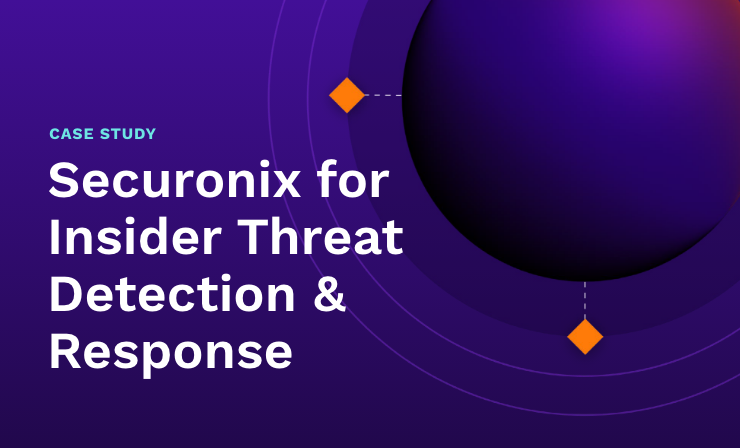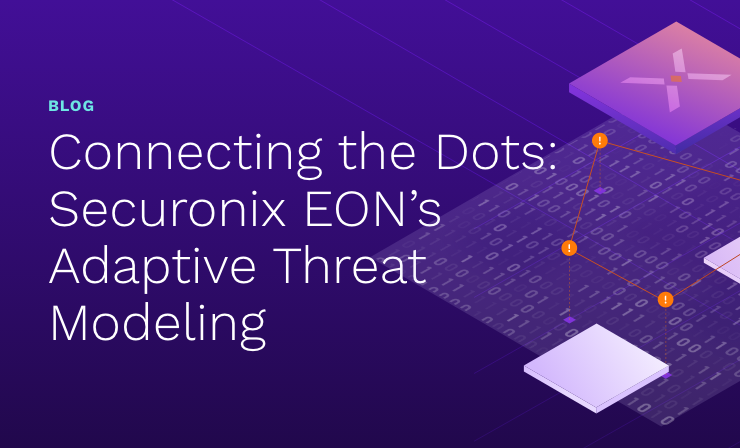- Why Securonix?
- Products
-
- Overview
- 'Bring Your Own' Deployment Models
-
- Products
-
- Solutions
-
- Monitoring the Cloud
- Cloud Security Monitoring
- Gain visibility to detect and respond to cloud threats.
- Amazon Web Services
- Achieve faster response to threats across AWS.
- Google Cloud Platform
- Improve detection and response across GCP.
- Microsoft Azure
- Expand security monitoring across Azure services.
- Microsoft 365
- Benefit from detection and response on Office 365.
-
- Featured Use Case
- Insider Threat
- Monitor and mitigate malicious and negligent users.
- NDR
- Analyze network events to detect and respond to advanced threats.
- EMR Monitoring
- Increase patient data privacy and prevent data snooping.
- MITRE ATT&CK
- Align alerts and analytics to the MITRE ATT&CK framework.
-
- Industries
- Financial Services
- Healthcare
-
- Resources
- Partners
- Company
- Blog
Insider Threat
By Findlay Whitelaw, Field CTO, Insider Threat Program and UEBA Solutions, Securonix
Sustained global economic volatility brings uncertainty to businesses and the workforce. The increased emphasis on reducing operational spending, ongoing layoffs, the evolution of hybrid working strategies, and the cost-of-living crisis are personal and professional challenges that may cause individuals to feel financially insecure at work and at home. With most of the attention on external threats such as ransomware, organized crime, and state-sponsored attacks, insider threats can be even more damaging to enterprises and should not be ignored.
The insider threat landscape is dynamic, and the persistent, diverse challenges these threats pose can be significant. Since insiders are often trusted individuals with legitimate access to critical systems and sensitive data, preemptively detecting their motives and intent can be daunting. Understanding the vital role of technical and behavioral indicators in identifying, mitigating, and protecting against such threats is foundational to a successful insider threat program and improving overall cyber resiliency.
What is an Insider Threat?
An insider threat arises from individuals within an organization—such as employees, former employees, contractors, or business associates—who have inside information concerning the organization’s security practices, data, and computer systems.
The threat that these insiders pose can involve theft, fraud, espionage, or sabotage. For a deeper dive into the nature and impact of insider threats, refer to our detailed blog: What Are Insider Threats?.
Types of Insider Threats
Insider threats can be categorized into several types based on the intent and mechanism of the action. The three primary types include:
- Malicious Insiders who intentionally misuse their access to harm the organization.
- Negligent Insiders who unintentionally cause harm through careless behavior or lack of awareness.
- Infiltrators who gain employment specifically to commit espionage or sabotage.
Understanding these categories helps organizations tailor their defensive strategies more effectively and recognize potential threats before they result in significant damage.
Potential Insider Threat Indicators
To effectively manage and mitigate insider threats, it’s crucial to understand the indicators that can signal potentially harmful activities within an organization. These indicators are typically categorized into technical and behavioral types, each providing critical insights that can help in early detection and response strategies.
Technical indicators
Technical indicators are typically associated with the digital traces left by user activities, which can be difficult to identify with insider threats. Security teams can look for signals, including unusual data access patterns, abnormal network traffic, unusual system logon times, or large volumes of sensitive data in unexpected locations. Implementing sophisticated user and entity behavior analytics (UEBA) tools can help organizations recognize anomalous behavior and potentially malicious activities.
For example, UEBA can detect sudden mass downloads or data transfers, repeated attempts to access restricted areas or files, and unauthorized external storage devices. These technical indicators can further escalate the risk if individuals are on an observation list as known leavers. Machine learning (ML) algorithms can augment detection by leveraging historical data patterns to identify and alert unusual activities. Furthermore, security organizations can be benchmarked against users’ previous behavior, activity, and peer groups to offer a broader assessment of any potential insider threats.
Behavioral indicators
Behavioral indicators apply to the human element of the detection equation. Human elements significantly contribute to the complexity of insider threats. Insider threats are often precipitated by changes in behavior, which can serve as early warning signs of a potential issue. Financial stressors or psychological factors can motivate harmful actions, while personal and personnel security practices can mitigate or amplify the risk.
Behavioral cues may range from observable disgruntlement or dissatisfaction, decreased productivity, and frequent conflicts with co-workers to more subtle signs, such as evidence of unexpected lavish lifestyle changes or individuals living beyond their means. Other behaviors can include erratic attendance, changes in mood, substance abuse issues, and working unusual hours. Another frequent indicator is when individuals violate organizational IT and data management policies.
Six Common Insider Threat Indicators
Understanding specific behaviors that may indicate an insider threat is crucial for timely and effective intervention. Below are six common indicators that security teams should monitor to preempt potential security incidents:
- Unusual data movement
- Viewing data not applicable to role
- Using unsanctioned software
- Renaming files
- Requesting escalated access
- Departing employees
Recognizing these signs early can be pivotal in mitigating risks and protecting sensitive information. It’s important for organizations to establish protocols that can swiftly address these behaviors, ensuring they do not escalate into more serious security breaches.
Convergence of technical and behavioral indicators through analytics
Understanding technical and behavioral indicators is pivotal to identifying insider threats. Technical indicators, such as unusual access patterns or data transfers, combined with behavioral indicators, like changes in work habits or attitudes, create a comprehensive profile of potential risks. Threat profiles and insider threat drivers highlight the diversity of insider threats and underscore the importance of recognizing behavioral indicators and understanding technical indicators.
This holistic approach enhances threat detection by recognizing insider threats, often involving technological misuse and human factors. The importance of these indicators lies in their ability to highlight anomalies that enable early detection and prevention of insider threats. By integrating these two dimensions, organizations can predict, detect and mitigate insider threats more effectively.
The multifaceted nature of insider threats necessitates a comprehensive approach. Motivated employees who want to cause significant harm to an organization intentionally don’t have to find clever ways to penetrate the network because they already have legitimate access. They know where valuable data and systems reside and how to gain access and circumvent controls.
Next-generation security information and event management (SIEM) and UEBA solutions can recognize abnormal behavior observed from potential insider activity indicating malicious intent. These capabilities provide context to the behaviors, actions, and alerts that can be correlated to insider threat models.
Understanding these concepts and how the convergence of technical and behavioral indicators can detect insider threats is critical to employing a proactive approach to insider threat management.







